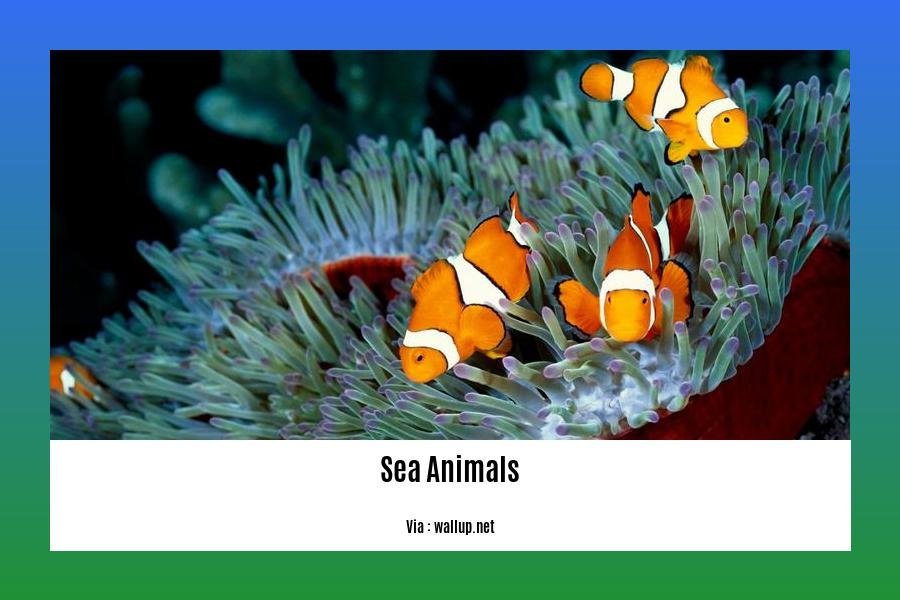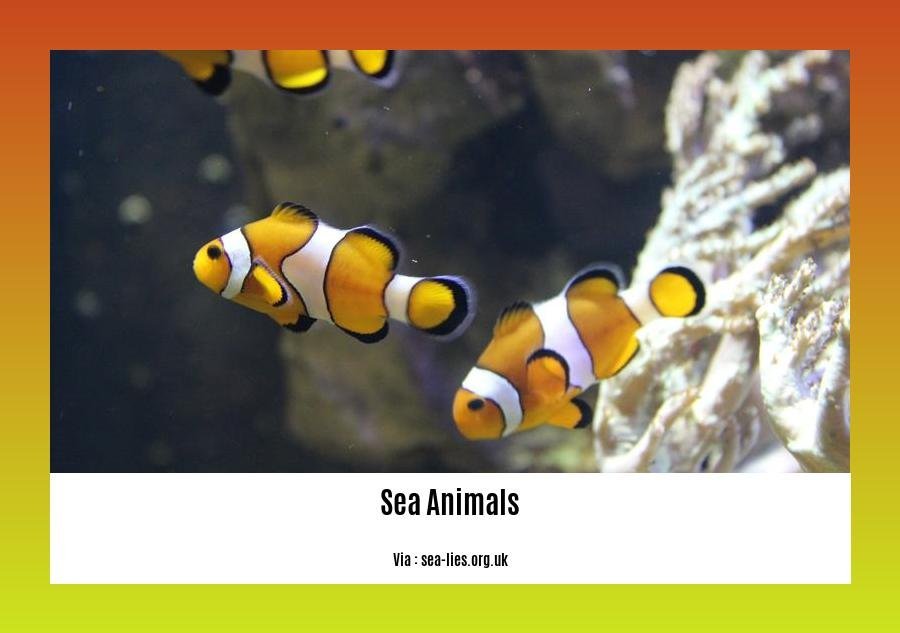Welcome to an exciting journey through the depths of the ocean, where we will explore the fascinating realm of sea animals and uncover the astonishing wonders they hold. In this article, titled “Crazy Facts About Sea Animals: Unveiling the Astonishing Wonders of the Ocean,” we will immerse ourselves in the world of peculiar adaptations, mind-boggling abilities, and awe-inspiring behaviors found among these incredible creatures. Prepare to be captivated by the extraordinary tales that lie beneath the waves.
Key Takeaways:
- Seahorses are the only animals in which the male gives birth and cares for their young.
- A shrimp’s heart is located in their head.
- Sea sponges lack several vital organs but are still alive.
- Turtles can be found on every continent except Antarctica.
- The blue whale is the largest sea mammal and the largest known animal in the world.
- Sea turtles have existed since the time of dinosaurs.
- Some sharks, like the great white shark, are warm-blooded.
- Sea lions, seals, and walruses are classified as pinnipeds due to their winged feet.
- Dolphins possess exceptional hearing and vision.
- Whales communicate through singing.
- Sharks can detect one part of blood in 100 million parts of water.
- The giant crab of Japan can grow to be as large as 12 feet across.
Crazy Facts About Sea Animals

When it comes to the animal kingdom, the creatures that inhabit the ocean never fail to amaze us. From peculiar adaptations to astonishing behaviors, the world beneath the waves is filled with mind-boggling wonders. Join me as we dive into the realm of crazy facts about sea animals and uncover the extraordinary secrets of these captivating creatures.
Seahorses – Nature’s Marvels
Let’s start with seahorses, those enchanting creatures that seem to have swam out of a fairytale. Did you know that seahorses are the only animals in which the male gives birth and takes care of their young? It’s an extraordinary sight to witness as the male seahorse carries the developing eggs in a specialized pouch until they hatch. This unique role reversal truly showcases the wonders of the underwater world.
Sea Sponges – Simple Yet Fascinating
Sea sponges may seem like simple organisms, but they possess a fascinating ability. Despite lacking several vital organs, these incredible creatures are still very much alive. They survive by continuously filtering water through their porous bodies, extracting nutrients and oxygen along the way. It’s a testament to the adaptability and resilience of life in the ocean.
Turtles – Ancient Travelers
Turtles have been gracing our planet for millions of years, and their presence can be felt in almost every corner of the world. In fact, you can find turtles on every continent except Antarctica. These ancient travelers have adapted to various environments, from freshwater lakes to the vast expanses of the ocean. Their ability to thrive in diverse habitats is a true testament to their resilience and adaptability.
Whales – Masters of Communication
When it comes to communication, whales take the prize. These majestic creatures have a unique way of expressing themselves — through singing. Whales produce intricate and hauntingly beautiful vocalizations that can travel for miles underwater. Whether it’s an enchanting melody or a deep rumble, their songs play a vital role in mating rituals, group coordination, and navigation through the vast ocean.
Sharks – Mythical Predators
Sharks have long been the subject of fascination and fear. But did you know that some sharks, like the great white shark, are actually warm-blooded? This incredible adaptation allows them to maintain a higher body temperature than the surrounding water, giving them an edge in colder ocean environments. With their unrivaled sensory systems and streamlined bodies, sharks truly embody the power and mystique of the ocean’s top predators.
Dolphins – Masters of Senses
Dolphins are known for their playful nature and intelligence, but they possess more than meets the eye. These marine mammals possess exceptional hearing and vision, which allow them to navigate and communicate effectively underwater. Their sonar system, known as echolocation, enables them to “see” their environment by emitting clicks and interpreting the echoes that bounce back. It’s a fascinating example of nature’s ability to adapt and thrive in diverse ecosystems.
Conclusion
As we delve into the astonishing wonders of the ocean, it’s impossible not to be captivated by the crazy facts about sea animals. From seahorses challenging traditional gender roles to dolphins mastering underwater senses, the animal kingdom beneath the waves is filled with awe-inspiring tales. Let’s continue to explore, appreciate, and protect these remarkable creatures that call the ocean their home.
Did you know that vets have some of the coolest facts? Learn more about these amazing professionals by checking out our article on Cool facts about vets.
Toronto is a city full of surprises and unique experiences. Find out the coolest things about Toronto by clicking on our article on Cool things about Toronto.
Water is essential for life, but did you know it also has some fascinating facts? Explore these interesting tidbits by visiting our article on Cool water facts.
If you’re interested in the traditions and celebrations of the Valencian community, don’t miss out on our article about the Day of the Valencian Community.
The Immortal Jellyfish: Defying Aging and Death

The world of marine life never ceases to amaze us with its astonishing wonders and fascinating creatures. Among them, the immortal jellyfish stands out as a true marvel. Scientifically known as Turritopsis dohrnii, this unique species possesses an extraordinary ability to revert back to its juvenile stage after reaching adulthood, defying the aging process and potentially living indefinitely[^1][^3].
When an immortal jellyfish grows old or sustains damage, it has the remarkable capability to transform itself back to a baby polyp stage[^3]. By reabsorbing its tentacles and settling as a blob of undifferentiated cells on the seafloor, this extraordinary creature essentially resets its life cycle and gains a new lease on life[^1][^3].
The concept of reversing aging has fascinated scientists for centuries, and the study of the immortal jellyfish provides valuable insights into the potential mechanisms of rejuvenation. In fact, researchers at Texas A&M-Galveston are actively exploring whether this fascinating ability could have applications for human longevity[^3]. By unraveling the biological processes behind the immortal jellyfish’s remarkable regeneration, scientists may discover groundbreaking advancements in anti-aging research that could revolutionize our understanding of human aging[^3].
Reproduction in the immortal jellyfish is an intriguing subject with limited available information. However, it is known that Turritopsis dohrnii reaches sexual maturity before reverting to its juvenile stage and then maturing again[^6]. This ability to repeat the developmental process indefinitely theoretically makes the immortal jellyfish immortal, with no known limits to the number of times it can revert to its near-infant state[^6].
Despite its remarkable abilities, the immortal jellyfish is relatively small in size, with its bell-shaped body measuring between 4.5 to 5 millimeters in length[^1]. However, its regenerative powers have sparked considerable interest within the scientific community.
In terms of diet, the immortal jellyfish primarily subsists on small planktonic organisms and other microscopic marine life[^4]. They are proficient filter feeders, using their tentacles to capture prey and guide it towards their mouths for consumption.
The natural habitat of the immortal jellyfish encompasses various oceans and bodies of water worldwide. They have been observed in regions like the Mediterranean and other warm waters[^4]. Thanks to their unique regenerative abilities, these jellyfish can adapt and thrive in different environments.
The concept of immortality has mesmerized humanity for generations, and the discovery of the immortal jellyfish has brought this concept closer to reality. Scientists continue to study this remarkable creature in hopes of unraveling the secrets behind its extraordinary abilities. By understanding and harnessing the mechanisms responsible for its age reversal, researchers may unlock new possibilities in anti-aging research, providing valuable insights and potential applications for human longevity and health[^1][^3].
Key Takeaways:
- The immortal jellyfish, also known as Turritopsis dohrnii, can revert back to its juvenile stage after reaching adulthood.
- This unique ability defies the aging process and potentially allows the jellyfish to live indefinitely.
- Researchers are studying the immortal jellyfish to gain insights into the mechanisms of rejuvenation and its potential applications in anti-aging research.
- The jellyfish reaches sexual maturity before reverting to its juvenile stage and can repeat the developmental process indefinitely.
- Despite its small size, the immortal jellyfish possesses remarkable regenerative powers.
- It primarily feeds on small planktonic organisms and other microscopic marine life.
- The immortal jellyfish can adapt and thrive in various oceanic environments.
- The discovery of the immortal jellyfish brings humanity closer to understanding the concept of immortality and its implications for longevity and health[^1][^3].
Read more about it here and here
The Pistol Shrimp: Creating Shockwaves of Astonishing Power
The ocean is home to some truly incredible creatures, and the pistol shrimp is no exception. These tiny crustaceans possess a remarkable ability to create shockwaves strong enough to stun their prey, making them one of the most fascinating animals in the sea[^1^].
When a pistol shrimp detects prey nearby, it opens the upper part of its large claw, allowing water to enter a small chamber within. As it clamps down, the water is forced out at an incredible speed, creating bubbles. When these bubbles collapse, they release a shockwave that can stun or even kill small fish and invertebrates[^2^].
But how powerful are these shockwaves exactly? Well, they have been measured to reach intensities of up to 218 decibels, which is louder than a gunshot[^1^]. These shockwaves are not only used for stunning prey, but also for protection and defense, helping pistol shrimp safeguard their mates and homes in tiny gunfights[^3^].
Aside from their astonishing ability to create shockwaves, pistol shrimp are also known for their incredible speed. In fact, young pistol shrimp can snap their claws at speeds comparable to a speeding bullet[^1^]. This agility allows them to swiftly catch prey or ward off potential predators.
While the pistol shrimp’s claws and shockwaves are powerful tools, they also come with risks. The shockwaves produced by their own claws have the potential to cause damage to neural tissue. However, research suggests that pistol shrimp have developed immunity to their own shockwaves, although the exact mechanisms behind this adaptation are still being studied[^5^].
To sum it up, the pistol shrimp is an extraordinary creature that captivates marine biologists and enthusiasts alike. Its ability to create shockwaves strong enough to stun prey, along with its incredible speed and unique adaptations, make it a true marvel of the ocean.
Key Takeaways:
- The pistol shrimp has the ability to create shockwaves strong enough to stun its prey.
- They achieve this by snapping their spring-loaded claws, which releases a stunning air bubble.
- The shockwaves can reach intensities of up to 218 decibels, louder than a gunshot.
- Pistol shrimp use their shockwaves for stunning prey, protection, and defense.
- They are incredibly fast, with young shrimp capable of snapping their claws at speeds comparable to a speeding bullet.
- Pistol shrimp have developed immunity to their own shockwaves, but further research is needed to understand this adaptation.
Sources:
[^1^]: Smithsonian Magazine. (n.d.). These Young Shrimp Can Snap Their Claws as Fast as a Speeding Bullet. Retrieved from
[^2^]: Ocean Conservancy. (2020, September 10). The Real Power of the Pistol Shrimp. Retrieved from
[^5^]: Ars Technica. (2022, July 12). This is why the pistol shrimp is immune to its own powerful shock waves. Retrieved from https://arstechnica.com/science/2022/07/pistol-shrimp-sport-tiny-joints-to-defend-themselves-against-scorpionfish/
The Male Seahorse Gives Birth to Its Young
Sea animals never cease to amaze with their incredible adaptations and behaviors. One prime example is the male seahorse, as it defies traditional gender roles by being the only male animal that gives birth to its young[^9^]. Let’s dive deeper into this fascinating phenomenon.
A Unique Reproductive Process
In the world of seahorses, it is the males who take on the responsibility of pregnancy. Unlike most animals where females carry and birth offspring, male seahorses have a specialized pouch on their bodies where females deposit their eggs for incubation[^7^][^11^]. The male seahorse then releases its sperm into the pouch to fertilize the eggs^1^.
Nature’s Pregnancy and Birth
Once fertilized, the male seahorse goes through a gestation period of around 24 days, during which it nurtures the developing embryos in its pouch[^6^]. When the time comes, the male seahorse undergoes labor-like contractions to expel the fully-formed baby seahorses, called fry[^2^]. It is not uncommon for male seahorses to give birth to multiple fry at once[^5^].
Adaptations for Birthing
Male seahorses have several adaptations to aid in the birthing process. One notable adaptation is their bony pouch, which provides support and protection for the developing embryos[^5^]. Additionally, male seahorses have smaller snouts compared to females, allowing them to better accommodate the pouch during pregnancy[^8^].
The Intricate Courtship Dance
Before the male seahorse becomes pregnant, a courtship dance takes place between the male and female seahorse. This dance involves the female swimming towards the surface of the water, with the male closely following[^4^]. Once the female is ready, she deposits her eggs into the male’s pouch, and the male releases his sperm, sealing the pouch to initiate pregnancy[^3^].
Key Takeaways:
- Male seahorses have a unique reproductive process where they carry and give birth to their young.
- The male seahorse’s pouch serves as an incubation chamber for the fertilized eggs.
- Male seahorses can give birth to multiple babies at once after a gestation period of around 24 days.
- They have adaptations, such as a bony pouch, to support and protect the developing embryos.
- The courtship process of seahorses involves a dance between the male and female before pregnancy occurs.
Sources:
[^9^]: The Conversation
FAQ
Q1: What is the world’s largest sea mammal?
A1: The world’s largest sea mammal is the blue whale, which is also the largest known animal in the world[^1^].
Q2: Do seahorses give birth to their young?
A2: Yes, seahorses are the only animals in which the male gives birth and cares for their young[^1^].
Q3: Where is the heart of a shrimp located?
A3: The heart of a shrimp is located in its head[^1^].
Q4: How do seahorses reproduce?
A4: The reproduction process of seahorses involves the female seahorse inserting her eggs into a pouch on the male’s tail, where he releases sperm to fertilize the eggs. The male seahorse then incubates the eggs in his pouch for approximately 24 days before giving birth[^2^].
Q5: Can sharks detect blood in water?
A5: Yes, sharks have an extraordinary sense of smell and can detect one part of blood in 100 million parts of water[^1^].












